Larynx Question And Answers
Question 1. Write a short note on larynx.
Answer:
Larynx
- It is the upper expanded part of lower respiratory tract.
- It is modified for the production of voice; hence it is called as voice box or organ of phonation.
Larynx Features
- It is located in the anterior midline of upper part of neck in front of the laryngopharynx.
- It extends from root of the tongue to the trachea and lies at the level of the C3, C4, C5, and C6 vertebrae.
- Till puberty, its size is more or less the same in males and females.
- But during puberty, male larynx grows larger and thus makes low pitched loud voice compared to high pitched voices in females and children.
Larynx Formation
- Larynx is formed by paired and unpaired cartilages.
- The paired cartilages include:
- Arytenoid cartilage
- Corniculate cartilage
- Cuneiform cartilage
- The unpaired cartilages include:
- Thyroid cartilage
- Cricoid cartilage
- Epiglottis
Muscles Of Larynx
- The muscles of the larynx include intrinsic and extrinsic muscles.
- Extrinsic muscles attach larynx to its surroundings and are responsible for movement of the larynx as a whole.
- Intrinsic muscles attach the laryngeal cartilages to each other.
Joints of Larynx: The joints include
- The cricothyroid joint between the inferior cornua of the thyroid cartilage and side of the cricoid cartilage. It allows rotatory movements around transverse axis.
- The cricoarytenoid joint between the base of the arytenoid cartilage and the upper border of the lamina of the cricoid cartilage. It permits rotatory movements around a vertical axis.
Larynx Blood Supply
- Arterial supply: Up to the vocal folds by the superior laryngeal artery, a branch of superior thyroid artery, and below the vocal folds by the inferior laryngeal artery, a branch of the inferior thyroid artery.
- Venous drainage: Up to the vocal folds, the superior laryngeal vein drain into the superior thyroid vein, and below the vocal folds, the inferior laryngeal vein drains into the inferior thyroid vein.
Larynx Nerve Supply
- Sensory supply: Above vocal cords is supplied by the superior laryngeal nerve and below vocal cords by the recurrent laryngeal nerve
- Motor supply: All muscles of the larynx are supplied by recurrent laryngeal nerve except cricothyroid which is supplied by external laryngeal nerve.
Larynx Lymphatic Drainage: Lymph from parts above vocal folds are drained into an anterior-superior group of deep cervical nodes and parts below vocal folds is drained into a posteroinferior group of deep cervical nodes.
Larynx Applied
- Laryngomalacia is the commonest congenital anomaly of the larynx.
- It results in excessive flaccidity of the supraglottic larynx and causes stridor on inspiration and may lead to cyanosis.
- The laryngeal web refers to the web seen between the vocal cords and occurs as a result of the incomplete recanalization of larynx.
Question 2. Write a note on the cartilages of larynx.
Answer:
Cartilages of larynx
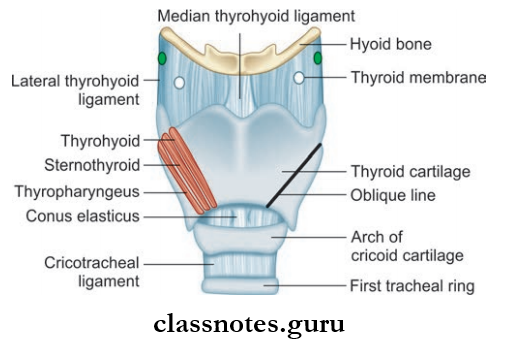

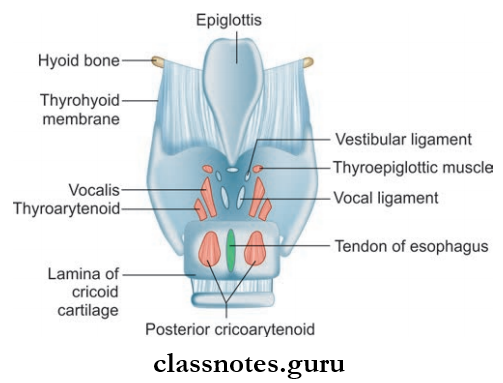
- Larynx is made up of nine cartilages.
- Among the nine cartilages, three are paired and three are unpaired.
- The paired cartilages include:
- Arytenoid cartilage
- Corniculate cartilage
- Cuneiform cartilage
- The unpaired cartilages include:
- Thyroid cartilage
- Cricoid cartilage
- Epiglottis
Thyroid Cartilage
- Thyroid Cartilage is the most prominent cartilage of the larynx.
- Thyroid Cartilage consists of two quadrilateral laminae which meet in front and form thyroid angle.
- The thyroid angle is prominent in males and measures about 90 degrees in males and 120 degrees in females.
- The posterior surface provides attachment for thyroepiglottic ligament, vestibular ligaments, and vocal ligaments.
- The posterior border of each lamina has upper and lower prolongations known as superior and inferior cornu or horn.
- The salpingopharyngeus, palatopharyngeus, and stylopharyngeus are attached to the cornu.
- There is an oblique line in the outer surface of each lamina where thyrohyoid, sternothyroid, and inferior constrictor muscles are attached.
Cricoid Cartilage
- Cricoid Cartilage is signet ring-shaped cartilage with a narrow anterior arch and broad posterior laminae.
- It is situated at the level of C6 vertebrae and completely encircles the lumen of the larynx.
- A median ridge is present on the posterior surface of the lamina.
Larynx Of Cartilage Epiglottis
- Larynx Of Cartilage Epiglottis is a leaf-like cartilage of the larynx that is present behind the hyoid bone and base of the tongue.
- Larynx Of Cartilage Epiglottis has a free upper end which is broad and forms the upper boundary of the laryngeal inlet and the lower end is connected to the posterior surface of the angle between thyroid cartilages.
- The anterior surface is connected to the base of the tongue by median and lateral glossoepiglottic folds.
- The depression on each side of the median folds is known as vallecula.
Arytenoid Cartilages
- These articulates with the upper border of the cricoid lamina.
- Arytenoid cartilage is pyramidal in shape and has an apex, base, three surfaces (posterior, medial, and anterolateral), and two processes (muscular and vocal).
- Apex is curved posteromedially and articulates with corniculate cartilage.
- Base is concave and articulates with the upper border of the lamina of the cricoid cartilage.
Corniculate Cartilages Of Santorini
- There are two conical nodules that articulate with apices of arytenoid cartilages.
- They lie in the posterior part of the aryepiglottic folds.
- Cuneiform Cartilages of Weisberg
- These are rod-shaped cartilages lying in the posterior part of aryepiglottic folds above corniculate cartilages.
Larynx Of Cartilage Applied
- Acute epiglottitis refers to the acute inflammation of the epiglottis and is confined to the supraglottic structures.
- As a result of the inflammation, there is marked edema of these structures, leading to airway obstruction.
Question 3. Write a note on the muscles of larynx.
Answer:
Muscles Of Larynx
The muscles of the larynx include intrinsic and extrinsic muscles.
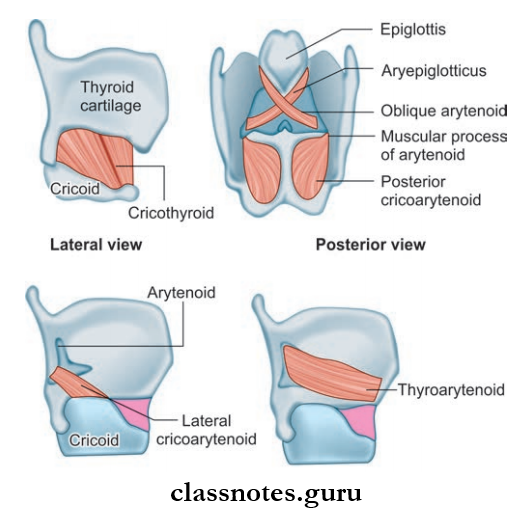
Extrinsic Muscles
- They attach the larynx to the surroundings and are responsible for the movement of the larynx as a whole.
- They are paired in nature.
- They Include:
- Palatopharyngeus
- Salpingopharyngeus
- Stylopharyngeus
- Throhyoid
- Sternothyroid
Intrinsic Muscles
- They attach the laryngeal cartilage to each other.
- They Are Involved In:
- Opening and closing of laryngeal inlet.
- Increasing and decreasing tension of vocal cords.
- Adduction and abduction of vocal cords.
According To The Actions, They Are Grouped Into The Following:
- Muscles That Open Or Close Laryngeal Inlets
- Opening Of Laryngeal Inlet: Throepiglotticus
- Closing Of Laryngeal Inlet: Oblique arytenoids
- Aryepiglotticus
- Muscles That Adduct Or Abduct The Vocal Cords
- Adductors: Lateral cricoarytenoids
- Transverse arytenoids
- Abductor: Posterior cricoarytenoid
- Adductors: Lateral cricoarytenoids
- Muscles That Decrease Or Increase The Tension Of Vocal Cords
- Tensors: Cricothyroid
- Relaxer: Throarytenoid and vocalis.
Cricothyroid Muscle
- Cricothyroid Muscle attaches the cricoid cartilage to the thyroid cartilage.
- Cricothyroid Muscle causes tensing and adduction of vocal cords.
- Cricothyroid Muscle is supplied by the external laryngeal nerve.
Vocalis Muscle
- The Vocalis Muscle is the detached medial part of the thyroarytenoid and lies within the vocal fold lateral to vocal ligament.
- Vocalis Muscle originates from the thyroid angle and is inserted to the vocal process.
- Vocalis Muscle causes the tensing of vocal ligaments and thereby modulation of voice.
- Vocalis Muscle is supplied by the recurrent laryngeal nerve.
Posterior Cricothyroid
- Posterior Cricothyroid is a triangular muscle extending from the posterior surface of the cricoid lamina to muscular process of the arytenoid.
- Posterior Cricothyroid causes abduction of vocal cords.
- Posterior Cricothyroid is supplied by the recurrent laryngeal nerve.
Muscles Of Larynx Applied
- Unilateral recurrent laryngeal nerve paralysis can lead to ipsilateral paralysis of all intrinsic muscles except cricothyroid and vocal cords assuming a median or paramedian position. This condition is usually undetected in the majority and others may present with airway obstruction.
- Bilateral recurrent laryngeal paralysis can result in paralysis of all intrinsic muscles of the larynx and vocal cords lie in the midline and also results in dyspnea and stridor.
- Muscles Of Larynx is treated as an emergency and tracheostomy is usually done.
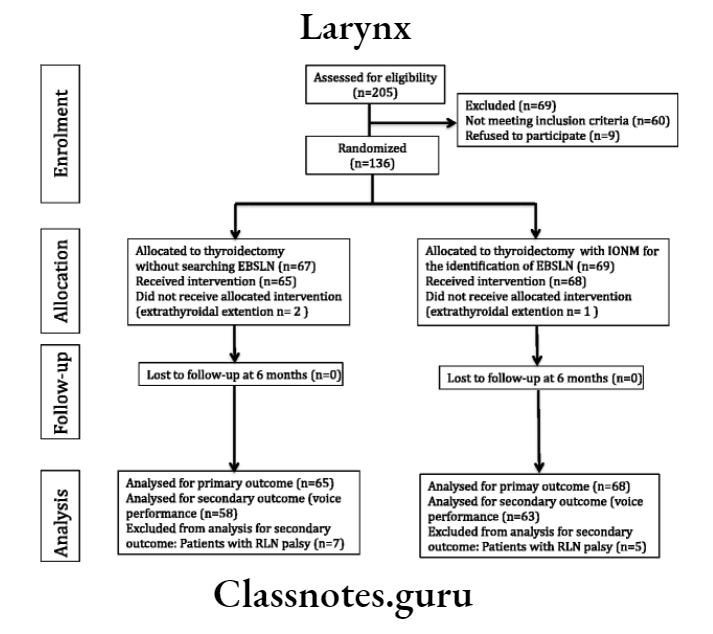
Question 4. Write a note on the cavity of the larynx.
Answer:
Cavity Of Larynx
Cavity Of Larynx extends from the inlet of larynx to the lower border of the cricoid cartilage.
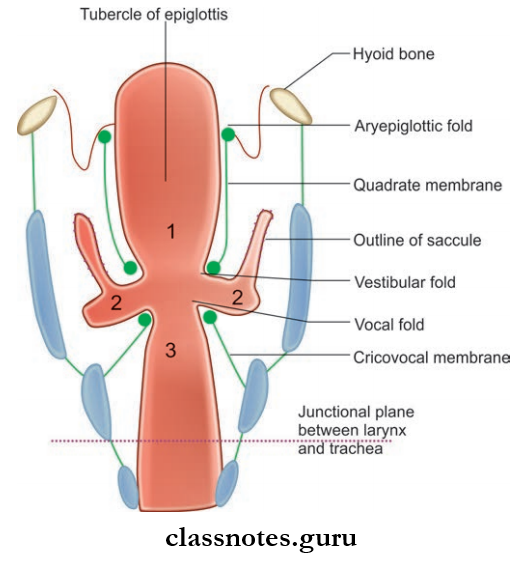
Cavity Of Larynx Boundaries
- Anteriorly: Epiglottis
- Posteriorly: Interarytenoid fold of mucous membrane
- Laterally: Aryepiglottic fold of mucous membrane
Cavity Of Larynx Features
- Within the cavity of the larynx, two pairs of folds of mucous membrane extend posteroanterior from arytenoid cartilage to thyroid cartilage.
- The upper folds are produced by the vestibular ligament and are called vestibular folds or false vocal cords and the space between them is known as rima vestibuli.
- They mainly prevent aspiration of food and liquids.
- The lower folds are produced by vocal ligaments and vocalis muscle and are called vocal folds or true vocal cords and the space between them is called rima glottidis.
- The rima glottidis is the narrowest part of the larynx and is longer in males than in females.
- The rima glottidis consists of an anterior intermembranous part and a posterior intercartilaginous part.
- The rima glottidis is limited posteriorly by an interarytenoid fold of mucous membrane.
Cavity Of Larynx Subdivisions: The laryngeal cavity is divided into three
- Supraglottic compartment
- Glottic compartment
- Infraglottic compartment.
Cavity Of Larynx Applied
- The process of visualization of the laryngeal cavity is known as laryngoscopy. It can be direct or indirect.
- Direct laryngoscopy is done by using a direct laryngoscope and indirect laryngoscopy is done by using a laryngeal mirror.
- Acute laryngitis refers to the inflammation of the larynx and is usually associated with upper respiratory tract infection.
- Reinke’s edema refers to the edema of the subepithelial space (Reinke space) of vocal cords.
- It is characterized by bilateral swelling of the membranous part of vocal cords, leading to hoarseness of voice and low-pitched voice.
Larynx Multiple Choice And Answers
Question 1. Which of the following cartilages completely encircles the laryngeal cavity?
- Thyroid
- Cricoid
- Epiglottis
- Arytenoid
Answer: 2. Cricoid
Question 2. All of the following cartilages of the larynx are composed of hyaline cartilage except:
- Epiglottis
- Thyroid
- Cricoid
- Arytenoid
Answer: 1. Epiglottis
Question 3. All of the following structures form the boundaries of the laryngeal inlet except:
- Epiglottic fold
- Interarytenoid fold
- Lamina of thyroid cartilage
- Aryepiglottic fold
Answer: 3. Lamina of thyroid cartilage
Question 4. The space between the right and left vocal folds is called:
- Vestibule
- Vallecula
- Rima vestibuli
- Rima glottidis
Answer: 4. Rima glottidis
Question 5. All of the following muscles adduct vocal folds except:
- Lateral cricoarytenoid
- Posterior cricoarytenoid
- Throarytenoid
- Interarytenoid
Answer: 2. Posterior cricoarytenoid
